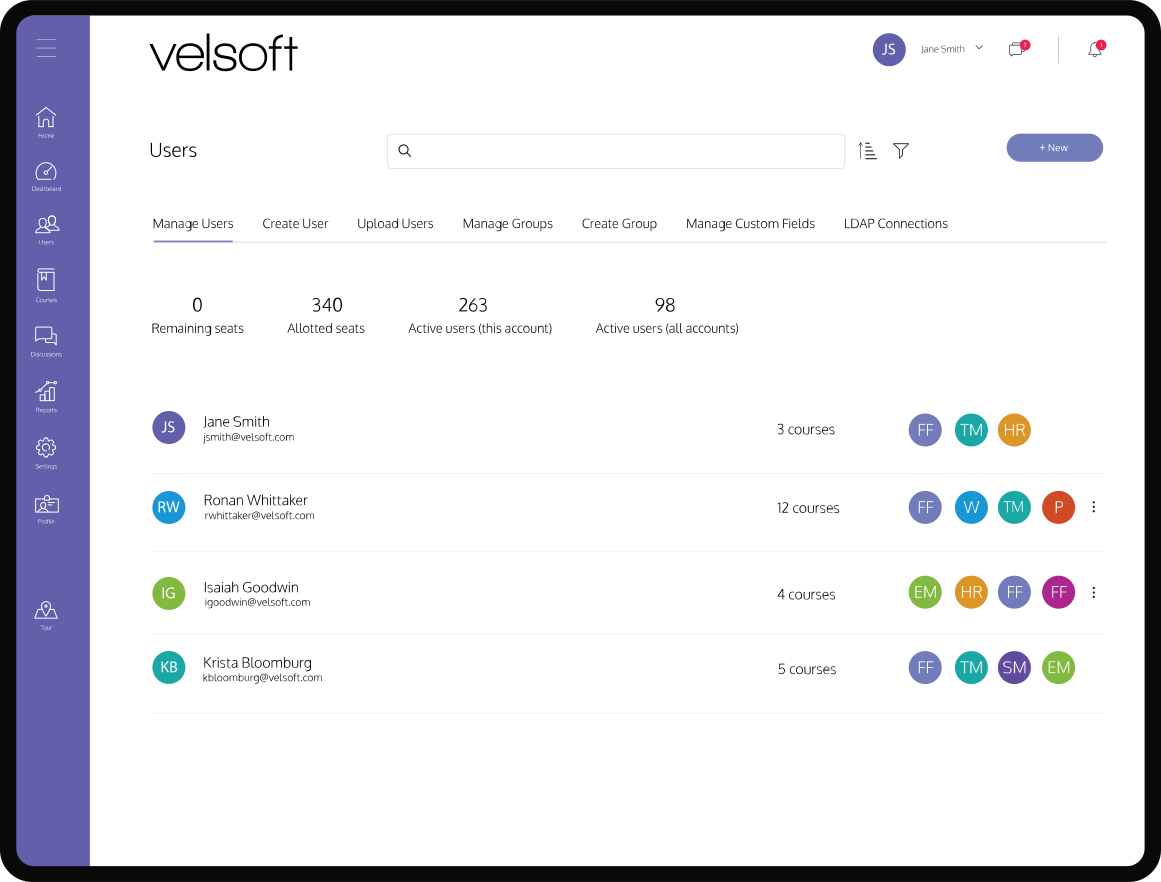Exploring 2025’s Biggest Trends in Learning & Development with Velsoft

In the ever-evolving world of corporate training and development, staying ahead of the curve is essential. As we look towards the future of training and development, understanding the latest learning and development trends 2024 is crucial. Velsoft, a leader in digital education, recently hosted a webinar to explore the latest trends in Learning and Development (L&D) for 2025.

This event featured insights from seasoned experts, including Joshua Randall, Velsoft’s National Sales Manager, who has 15 years of experience in consulting, training, sales, and finance. Joshua has successfully implemented upskilling and reskilling programs at major companies such as Toyota, BMO, and Telus, showcasing the impact of new training methods in various industries.
Who is Velsoft?
Velsoft is a leader in digital education and content creation, with more than 150 online schools, and hundreds of eLearning and Instructor-led training courses covering today’s critical workplace topics and skills. With a team of more than 60 instructional designers, eLearning experts, and edtech developers, Velsoft serves more than 6,000 clients across 164 countries, demonstrating a commitment to innovation and excellence for over two decades. Their expertise in corporate learning trends positions them at the forefront of L&D innovation.
The biggest trends shaping the future of L&D:
During the webinar, we covered several key areas shaping the future of L&D, highlighting the hot topics in training and development that are transforming the industry:
- Personalized Learning
- Microlearning
- Mobile Learning
- Doing More with Less
- Solving Business Problems
- Reskilling
- L&D Takes Centre Stage
Personalized Learning
Remember when everyone got the same training? Personalized learning is moving away from the traditional “one-size-fits-all” model and embracing the power of customization to tailor training to the individual learner. This approach to learning and development models focuses on creating personalized learning paths that cater to each employee’s unique needs and goals.
With tools like AI-driven personalization, companies can identify skills gaps, recommend relevant content, and create learning paths that accelerate skill development. This not only reduces training time by up to 50%, as highlighted in the LinkedIn Learning 2024 Workplace Learning Report, but it also boosts employee engagement and knowledge retention.
Unilever’s “Flex Experiences” platform exemplifies this trend, using AI to customize leadership development training based on real-time data, ensuring that leaders receive targeted development opportunities precisely when they need them. This approach allows companies to maximize the impact of their L&D investments while promoting work-life balance through flexible, personalized learning experiences.
Microlearning
Microlearning, focuses on delivering bite-sized, digestible learning content. This approach has proven effective in enhancing engagement and retention. By breaking down complex topics into smaller, more manageable pieces, microlearning caters to the modern learner’s preference for concise and focused information.
Companies like Walmart have successfully reduced compliance training time by 60% through their “Daily Learning Bursts”. These short, focused learning bursts fit seamlessly into busy schedules and reinforce key concepts, leading to improved knowledge retention and application. This approach exemplifies the shift towards learning in the flow of work, allowing employees to acquire new skills without disrupting their daily tasks.
Mobile Learning
In today’s fast-paced, always-connected world, mobile learning has become indispensable. It empowers employees to learn on the go, anytime, anywhere, breaking free from the constraints of traditional classroom settings. This trend is particularly important for supporting a hybrid workforce, where employees may be working from various locations.
VelsoftLMS is a cloud-based, easy to use Learning Management System that allows is accessible by trainers, admins, students and trainees – anytime, anywhere.

According to EHS Today, nearly 90% of frontline workers access training via mobile devices, highlighting the widespread adoption of this approach. Starbucks turned their whole barista training program into something that looks more like Instagram Reels or Tik Tok Videos than corporate training. This approach caters to the preferences of younger generations, who are accustomed to consuming information in short, visually appealing formats. The result? New baristas are getting up to speed almost twice as fast, demonstrating the effectiveness of innovative training methods in addressing multigenerational training needs.
Doing More with Less
Let’s face it, L&D teams today are being asked to do more with less, and it’s a challenge! But there’s good news. By embracing smart solutions like automation and AI-powered learning, repetitive tasks that drain time and energy can be ditched – think content creation and administration – and finally focus on high-impact work. Things like data-driven L&D decisions and tech tools can also help stretch budgets further. Just look at Maersk’s AI-powered “Learning Hub” – they slashed L&D costs by a whopping 45%! That’s the kind of efficiency that creates truly effective training programs and makes a real difference for organizations.
Solving Business Problems
L&D is no longer viewed as a cost but as a strategic partner in solving business challenges. This requires a shift in mindset, moving away from generic training programs and towards targeted interventions that address specific business needs. This approach emphasizes the importance of ROI in training and aligns L&D initiatives with broader organizational goals.
Take Siemens’ “Digital Twin Academy,” for instance – they reduced equipment downtime by 25% through AR simulations, demonstrating the tangible benefits of aligning L&D with operational challenges. This example showcases the potential of immersive learning technologies like virtual reality (VR) and augmented reality (AR) in creating impactful training experiences. That’s the kind of result that makes CEOs pay attention and highlights the strategic value of L&D in driving business success.
Reskilling for the Future
The world of work is changing fast, and emerging skills in workplace learning are constantly evolving. With rapid changes in technology and evolving industries, the World Economic Forum predicts that 60% of employees will require significant upskilling or reskilling by 2030. This means that reskilling the workforce for the challenges of tomorrow is no longer a luxury but a necessity for organizational survival.
Initiatives like Accenture’s “LearnVantage,” which trained 150,000 employees in generative AI tools, are setting the standard for proactive reskilling. By investing in future-proof skills, organizations can ensure their workforce remains adaptable, resilient, and prepared to thrive in the face of change. This approach to reskilling often includes a focus on both technical skills and soft skills training, recognizing the importance of a well-rounded skill set in the modern workplace.
Velsoft has hundreds of ready-made, customizable courses written by subject matter experts, professional editors, and designers. These courses are easily customizable so you can tailor them to meet your specific needs and goals.
You can view, and access hundreds of sample courses in our Sample Download Center.
L&D Takes Centre Stage
As companies recognize the crucial role L&D plays in driving organizational growth, innovation, and competitive advantage, they are investing more heavily in their L&D programs. This shift reflects the growing importance of professional development trends in shaping the future of work.
Gartner’s 2024 HR Priorities Survey highlights a 12% increase in L&D budgets, reflecting its growing importance in shaping the future of work. This increased investment allows L&D departments to develop and implement cutting-edge training programs, leverage innovative technologies, and build a culture of continuous learning within their organizations. As a result, L&D is becoming a key driver of talent development, organizational transformation, and long-term success.
Business Trends for 2025: AI and Automation
What should you take away from this? AI and training are revolutionizing L&D by making things more efficient and personalized for trainers and trainees! The impact of technology on training is profound, with 65% of L&D departments using generative AI for content creation, highlighting the shift towards a more automated future. IBM’s “Watson Orchestrate” demonstrates the real-world impact of artificial intelligence in L&D, freeing 20% of trainers’ time for strategic work.
In conclusion, L&D professionals can expect to see AI and automation continue to transform L&D with personalized learning, microlearning, mobile access, and strategic alignment taking center stage. The future of corporate training trends points towards a more adaptive, data-driven, and human-centric approach to learning.
Want to watch the live Webinar hosted by Joshua Randall on 2025 Super Trends for L&D? Watch here: Velsoft Webinar – 2025 Super Trends
While the trends in L&D discussed here were intentionally designed to cover a broad range of organizations, we understand that your business has unique initiatives, plans, and challenges. The future of learning in 2025 and beyond will likely involve a combination of these trends, tailored to meet the specific needs of each organization.
If you want to talk about your specific goals and challenges, we invite you to book a free 1:1 consultation with one of our training specialists: Book a Free Consultation – Educational Content and eLearning Technology


